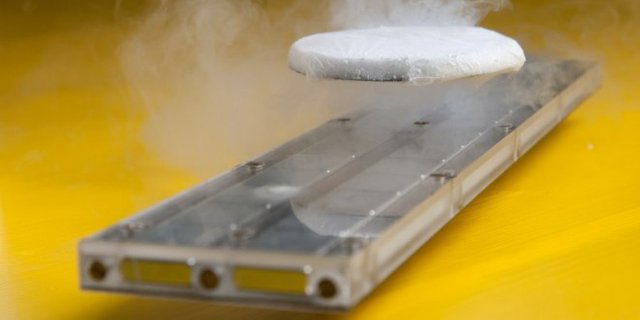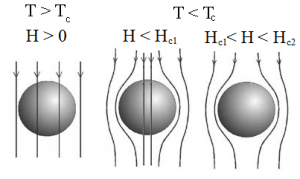
Conduction in metals
The notion that metals are good electrical conductors because the electrons move freely between the atoms, in sort of a delocalised sea, was first introducedby Drude in 1900, a mere 5 years after the original discovery of the electron! Although Drude's original model did not include quantum mechanics, his formula for the conductivity of metals remains correct even in the modern quantum theory of metals.
The wave functions of the electrons in crystalline solids obey Bloch's theorem, which essentially means there is no energy cost associated with the tunnelling of electrons between different lattice sites! The energies of the Bloch states give rise to energy bands, which characterise the allowed energies of the electrons in the solid.
In order to understand superconductivity, we must first understand what brings about resistance. Well, resistance is all to do with scattering; that is, electrons bashing into one another, or bashing into impurities in the solid, or even bashing into phonons (aka: quasiparticle associated with lattice vibrations). All these various scattering processes impede electron transport, which is why we call it resistance.
Superconducting materials
A number of the elements in the periodic table become superconducting at low temperatures. Familiar friends such as aluminium, lead and tin all exhibit superconductivity, but niobium becomes superconducting at the highest critical temperature, at atmospheric pressure. It was discovered fairly recently that you can make a fair few more elements exhibit superconductivity if you increase the pressure sufficiently. The kinds of pressure we're talking about here are only accessible by placing the sample between two anvil shaped diamonds, however!
Superconductivity
In a superconducting material, the resistivity is exactly zero at temperatures below the superconducting phase transition temperature. This means that the conductivity appears to manifest as infinite! Inside a superconductor, there must, therefore be zero electric field.
Now, I'd like to draw attention to the fact that when cooling your sample down, upon reaching the critical temperature, the resistivity sharply decays to zero - it's not a gradual thing. It's similar in some ways to phase transition you're absolutely aware of such as from liquid to gas (evaporation), where the properties on either side of the phase transition are wildly different.
This whole zero resistivity thing can bring about some really cool effects. One such effect is that of persistent currents. If we have a closed loop of superconducting wire, it is possible to set up a current circulating in the loop. Now, since there is no dissipation of energy (no resistance), the energy stored in the magnetic field of the ring will be constant (we think, forever!), as the current never decays.
Meissner-Ochsenfeld effect
This is a better way to define superconductivity - a superconductor is a material which exhibits the Meissner effect. Why? Well, it's possible for a non-superconducting material to have zero resistivity under certain conditions; a so-called, perfect conductor. Not all perfect conductors are superconductors, but all superconductors exhibit the Meissner effect. So what is it?
If a sample initially at high temperature, and in zero magnetic field is first cooled, and afterwards placed in a magnetic field, then the magnetic field cannot enter the material. This is a consequence of zero resistivity. On the other hand, a normal sample can be first placed in a magnetic field, and then cooled, in which case the magnetic field is expelled from the system. This effect is a property of thermal equilibrium.

In order to maintain zero magnetic field inside the sample, a superconductor must be a perfect diamagnet; nominally, one with a susceptibility of exactly -1. You can read up on diamagnetism in one of my old posts.
I hope you found this post informative, and you learned something new. In the follow up post (coming tomorrow) we will dig a little deeper and discover that in fact, there are two classifications of superconductors; namely, type I, and type II. Type II superconductors are quite amazing, exhibiting vortices that pass through the superconductor core. We'll also learn about their respective phase transition.
Catch you tomorrow, D.
Smooth! :-) Thank you.
Downvoting a post can decrease pending rewards and make it less visible. Common reasons:
Submit
Congratulations @diracdnb! You have completed some achievement on Steemit and have been rewarded with new badge(s) :
Click on any badge to view your own Board of Honnor on SteemitBoard.
For more information about SteemitBoard, click here
If you no longer want to receive notifications, reply to this comment with the word
STOPBy upvoting this notification, you can help all Steemit users. Learn how here!
Downvoting a post can decrease pending rewards and make it less visible. Common reasons:
Submit
You need a glossary for every other word in this article! :P
Downvoting a post can decrease pending rewards and make it less visible. Common reasons:
Submit
very informative!! love that there are people putting such specialist knowledge on line here at steemit!
It would be great to see you at our steemit meet up on 16th September in Birmingham!
If you can make it, there will be a free steemit t-shirt for you, live music from @branhmusic and 150 pounds behind the bar,
Please see link for more details! https://steemit.com/meet-up/@starkerz/promo-uk-steemit-meet-up-everyone-welcome-from-far-and-wide-come-see-the-steemit-laser
Downvoting a post can decrease pending rewards and make it less visible. Common reasons:
Submit
Congratulations @diracdnb! You have completed some achievement on Steemit and have been rewarded with new badge(s) :
Click on any badge to view your own Board of Honor on SteemitBoard.
For more information about SteemitBoard, click here
If you no longer want to receive notifications, reply to this comment with the word
STOPDownvoting a post can decrease pending rewards and make it less visible. Common reasons:
Submit